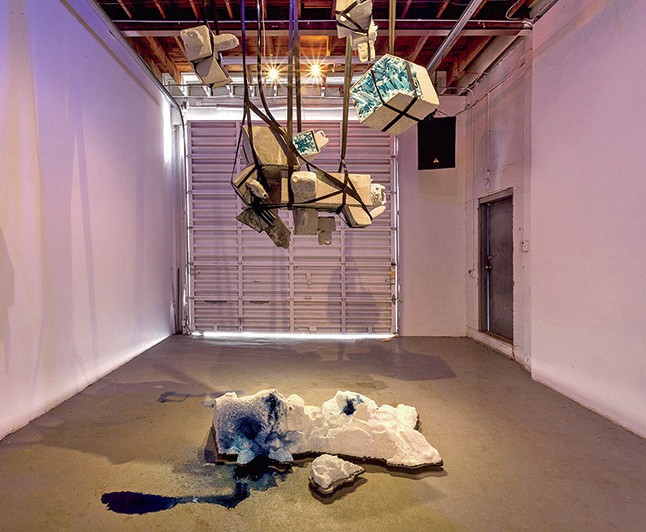Skating on Thin Black Ice
Mia Feuer, the Winnipeg-born, Oakland-based sculptor, is more than half in love with easeful black. She is the maker of a series of large-scale sculptures that challenge us to entertain questions about the way we are consuming the environment and altering the world we live in. I use the term entertain because her projects seduce you into looking before they hold you in the hard logic of their embrace. In her early 30s, Feuer may be the most environmentally engaged and aesthetically inventive sculptor of her generation. Two current exhibitions, one at Locust Projects in Miami called “Mesh” and the other at the Esker Foundation in Calgary, show what she has been making in the last two years. The Esker, called “Synthetic Seasons” (it runs from May 23 to September 6), is the larger of the exhibitions. It includes two new pieces, including one that connects with the work in Miami, and four sculptures she exhibited last year in “An Unkindness,” her survey exhibition at the Corcoran Gallery in Washington, DC.

An Unkindness, 2013, foam, leathers, tar paper, tar, wire, black enamel, shredded rubber tires and powdered glass, 15 x 30 x 10 feet, Corcoran Gallery of Art, Washington, DC. Photograph: Paul Bothwell. Courtesy the artist.
Among the works at the Esker is a 28-foot long and 16-foot wide skating rink made from high-density polyethylene, which allows you to skate on black synthetic ice. “I was thinking about the Canadian landscape and I had this memory of my dad, who was a goalie. He would do laps alone before the game and he would look so intense and so contemplative. I wanted to recreate that same space in a museum, but on an oily, black plastic hockey rink.”
Naomi Potter, the Esker’s director and curator, regards Feuer’s art as particularly important for Calgary, where oil is a way of life. “We need to talk about these issues in ways that are not so polarized. Mia’s work is a way to encourage that conversation. It is striking, intense and also very poetic. You see it as a sculpture first and then as work that thinks very clearly about these critical issues.”

Installation view, “MESH,” 2015, Locust Projects, Miami. Photograph: Zack Balber, Ginger Photography Inc. Image courtesy the artist and Locust Projects.
Feuer realizes that showing her sculpture in a city like Calgary could be contentious. But she also recognizes that the problems she is addressing go beyond the province of Alberta. “What I’ve learned from the work I’ve been doing is that everything is interconnected; the drought here in California is part of it; and when I go to Miami and people talk about real estate and rising ocean levels, that is another part of it; and when I’m in the Arctic and I see glaciers fall into the ocean because of global warming, that is also part of it.”

Installation view, “MESH,” 2015, Locust Projects, Miami. Photograph: Zack Balber, Ginger Photography Inc. Image courtesy the artist and Locust Projects.
Feuer thinks that contemporary artists have a responsibility to respond to the times in which they live and she believes that climate change is “the conversation of our time; it trumps everything. And how effective is art in addressing these concerns? It’s an impossible thing to measure, but I do know that when art is in the public sphere, it can move someone emotionally. If you can just move someone to have a new perspective, to ask more questions, or look at something in a different way, I think that is pretty huge. I don’t want to say something romantic like art can change the world. But can it make a difference? Fuck, yes, it makes a difference.” ❚

